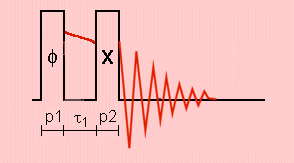Introduction to two-pulse MAS NMR
Aim: Optimization of the central-line intensity using a two-pulse sequence with a short interpulse delay where the first pulse excites the ±p-quantum coherences simultaneously. The powder sample is in a rotor spinning at the magic angle.

Usually, an MQMAS NMR experiment on half-integer quadrupolar spin starts with the optimization of the ±p-quantum coherences using a two-pulse sequence. The interpulse delay tau1 is about 10 µs. Phase cycling is applied so that the first pulse excites the ±p-quantum coherences simultaneously. The second pulse converts them to -1-quantum coherence.
The standard optimization procedure is a two-step experiment:
In the first experiment, we keep constant the first-pulse length p1 and acquire a series of spectra for increasing length p2 of the second pulse.
In the second experiment, we acquire a series of spectra for increasing length p1 of the first pulse, where p2 corresponds to that generating the highest spectrum line intensity in the first experiment.
